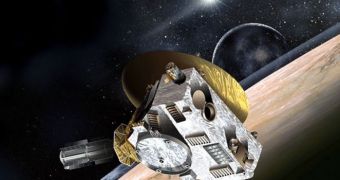Scientists at the American space agency are proud today to announce an impressive achievement of the New Horizons space probe, the fastest spacecraft every built. After years of traveling to the boundaries of the solar system, the instrument is finally closer to Pluto – its primary target – than it is to Earth. The milestone is reached after nearly four years of non-stop flight, but the spacecraft is not still halfway there. With 1,440 days of flight under its belt, New Horizons still has 1,928 days to go before close-approach operations begin, as well as 2,022 days until the point of closest approach.
The entire journey is scheduled to last for more than 9.5 years, NASA announces. The space probe is already 15 astronomical units (AU) away from the Sun. An AU is the equivalent of the mean distance between the Earth and the Sun, or roughly 150 million kilometers (93 million miles). It is estimated that Pluto, and the inner fringes of the Kuiper Belt, will be reached in the summer of 2015. The spacecraft will then begin the science stage of its mission, which will increase the astronomers' knowledge of the outer asteroid belt, as well as of Pluto and its moons, and their dwarf planet companions.
After launching in January 2006, the probe now finds itself some 2.4 billion kilometers (1.527 billion miles) away from home, traveling at an average speed of about 50,000 kilometers per hour (31,000 mph), experts say. They add that the spacecraft is performing wonderfully, with all systems functioning within their specified parameters. Telemetry reports show that New Horizons is almost dead-on on its planned course, which is no small feat, considering that minor calculation errors or deviations could translate in thousands of miles of deviation at the end of the journey.
In early January, its communication dish will be pulled out of hibernation. This will help mission managers conduct adjustments, and also test the various systems onboard. The probe will also send back large data sets, collected by the onboard Venetia Burney Student Dust Counter. A recently discovered bug in the fault protection system software will also be addressed, and new instructions that will drive the machine for the month will also be uploaded. This maintenance work is essential so as to ensure that the probe doesn't go into safe mode at the point of closest approach, Space Fellowship reports.

 14 DAY TRIAL //
14 DAY TRIAL //